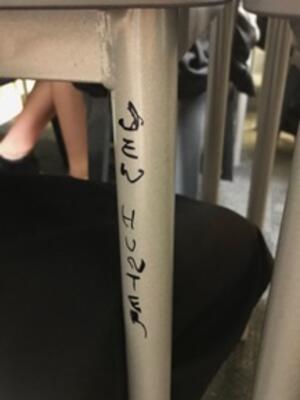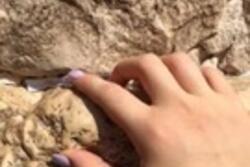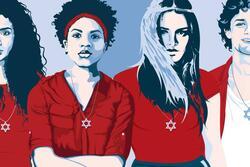May the Faith Be With You
On a rainy morning in March, my history teacher greeted the class with a direction:
“Raise your hand if you would have died in the Holocaust.”
Upon hearing his proposition, I became too infuriated to speak. Instead, questions flooded my brain. One stuck out from among the stream: Was I being targeted because of my religion?
This question, like the situation, was both a terrifying prospect and a new reality. The classroom I was sitting in was in Adelaide, Australia, almost 10,000 miles away from my home in Madison, Wisconsin. My dad’s sabbatical had led us to the state of South Australia for six months while he did research at a local university. My knowledge of Australia had been limited before arriving; I knew about the koalas, the Queen, and the left-side driving. What I had not expected was the minuscule number of Jews: Out of 25 million Australian citizens, there are around 90,000 self-identifying Jews (although that number is dropping fast). In South Australia, the Jewish population is 1,000, out of a total population of 1.7 million residents. To put those statistics in perspective, only a slightly higher number of Australians ticked the box for “Jewish” than for “Jedi” as their religion in the last census.
With a lightsaber as likely to appear in my class as a Star-of-David necklace, I was surprised to watch around half of the students raise their hands to join my own. My history teacher nodded, happy we had proved his point. “Yes,” he said, “The Nazis targeted those who didn’t look Aryan, those who didn’t have blond hair, blue eyes, or pale skin.”
I looked at my classmates who had risen their hands, students confident they would have met their demise under Hitler’s “Final Solution.” All had brown hair. Most had brown eyes. None were Jewish.
Although it is true that a significant number of non-Jewish people were targeted by Nazi propaganda and extermination campaigns, my teacher and peers demonstrated a pretty extreme misunderstanding of the facts. All groups attacked by Hitler’s policies were vilified for reasons directly relating to religion, race, nationality, political viewpoints, or sexual orientation, not solely appearance. Even if my teacher understood this distinction, he did nothing to educate my class on its implications in the Holocaust.
If I had been in my hometown, I would have sprinted to my friends after class, where even the non-Jewish ones would have been aghast at the false version of history that this teacher was preaching to students who already believed the same misconception. My friends and I would have banded together and confronted the teacher. We would not have let the fallacy go unchallenged. We would have stopped anti-Semitism in its tracks.
But in that Adelaide classroom, there was no “we.”
To add insult to injury, and ignorance to insensitivity, my history teacher avoided the subject of the Holocaust for the rest of our term-long unit on the Third Reich. He talked briefly about anti-Semitic propaganda but mostly stayed on the safer subject of Hitler’s political shenanigans. Although I had been exposed to the incomprehensible horrors of the Holocaust many times before in classes at both my temple and at American public schools, it was clear that this was the first time many of the Australian students in that class were interacting with such material. As a result, they couldn’t comprehend the importance of its absence in our class or why his original question had been so misguided.
Because I didn’t have support, because I felt alone, I didn’t confront my teacher about his words that day or about the lack of Holocaust education. I didn’t take a stand, either, when I found the words “JEW HUNTER” scrawled on the leg of a desk. Nor did I speak up when I found the same horrifying phrase on a different desk a few weeks later.
I shrugged the incidents off and even tried to laugh at them (one friend scratched out the “J” so the graffiti read “ew hunter”). But I couldn’t laugh off the deep effects of not having a community to turn to within my school. For so long, I had based my Jewish identity around the other Jews present in my life. I was Jewish because of the lessons I learned from my enthusiastic religious school teachers, the passionate sermons I heard from my Rabbi, the endless memories I shared with my URJ camp friends, and the events I planned with my temple’s youth group board. In Australia, I was forced out of this comfortable bubble and into a world where I couldn’t rely on others to define my Judaism for me. For a while, this meant that I silenced my identity to remain inconspicuous, terrified of my reputation being reduced to “the Jew” and nothing more.
Later in my visit, my friend’s brother came to pick her up from school and offered me a ride home. Conversation in the car quickly turned to a comparison between America and Australia, as was a common thread throughout my time there. When I asked him what it was like to be Muslim in Australia, he asked me about my own religious practices. I paused as I was consumed by an internal struggle over what to say next. I could stay hidden behind a safe but regrettable lie, ensuring I wouldn’t be met with more anti-semitism. Or, I could begin to accept that my culture, values, and memories as a Jewish person were an integral part of my identity, regardless of where I was and who I was surrounded by.
At that moment, the choice seemed obvious. I took a deep breath and told him the truth. “Wow,” he remarked. “You’re the first Jew I’ve ever met.” He wanted to know more: Do Jews have a God? What holidays do we celebrate? Did we also use the Quran? I answered him hesitantly at first, but my responses became more assured as our conversation progressed. Finally, I was able to take the first steps towards using my voice and finding confidence in my culture, feeling the presence of my Jewish community, even from 10,000 miles away, sustaining my every answer.
This piece was written as part of JWA’s Rising Voices Fellowship.








I am so impressed with your article! I know your Dad since he was born and I was your grandmother's, Joy Nathanson, very best friend!! Many years ago, I had an Austrailan exchange student living in our home and she learned a great deal about being Jewish. She went back home wearing a mezzuzah around her neck!!I She was in high school at the time. Regards to Dad. Bryna Ringel
I am so proud of you. It’s difficult to believe you are only 16. I know you will have a wonderful and productful future. Love.Nana
Wow!
emma YES! YES! you rock
In reply to emma YES! YES! you rock by Emma Cohn
Em, my words can’t express what a mature, beautiful piece you have shared.